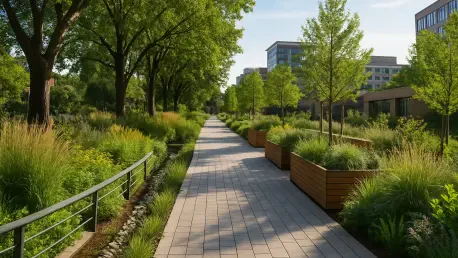In the heart of Racine, Wisconsin, a transformative project has reshaped the connection between downtown and the lakefront, marking a significant achievement for urban development and sustainability. A recent celebration at a prominent new apartment complex highlighted two major milestones that promise to enhance community life and environmental responsibility. The event showcased the completion of a public walkway and green space, alongside the prestigious recognition of Silver LEED Certification for the building. Developed by a local property firm, this five-story residential structure stands as a testament to innovative design and forward-thinking planning. The dual accomplishments not only improve accessibility for residents and visitors but also set a high standard for eco-friendly construction in the region. This noteworthy occasion reflects a broader commitment to enriching urban spaces while prioritizing the planet’s health, sparking interest in how such initiatives can inspire similar efforts elsewhere.
Enhancing Community Connections
The newly unveiled walkway and green space near the apartment complex have opened up previously inaccessible areas, creating a vital link from downtown Racine to the lakefront. Stretching from a central avenue to a nearby marina, this public area features two wide paths separated by lush greenery, ensuring a welcoming environment for pedestrians. Enhanced with security lighting for safety during evening hours, the space invites everyone to explore and enjoy the scenic surroundings. A representative from the development team emphasized that this area is not exclusive to tenants but is a shared asset for the entire community. This gesture of inclusivity has been warmly received, as it transforms a once daunting 30-foot drop-off into a safe and accessible pathway. The impact on local foot traffic is already evident, with more people strolling through to experience the revitalized connection to the water’s edge, fostering a sense of unity and shared pride in the city’s evolving landscape.
Beyond the physical transformation, this development underscores a broader vision of urban connectivity that benefits both residents and visitors. City officials have praised the project for bridging Main Street to the waterfront, enriching the downtown experience in a meaningful way. The collaborative effort between municipal leaders and private developers has turned a long-standing barrier into an opportunity for engagement, making the lakefront a more integral part of daily life. Such initiatives highlight the potential for thoughtful design to address historical challenges in urban planning, creating spaces that encourage interaction and exploration. The walkway’s design prioritizes accessibility, ensuring that individuals of all ages and abilities can navigate the area with ease. This milestone serves as a reminder of how strategic partnerships can yield lasting improvements, setting a precedent for future projects aiming to reconnect communities with their natural surroundings in innovative and inclusive ways.
Commitment to Sustainable Living
A standout achievement for this Racine development is its Silver LEED Certification, a distinction awarded by the U.S. Green Building Council for meeting rigorous standards in energy efficiency and environmental design. This recognition is particularly notable for an apartment complex, as such certifications are less common in residential projects compared to commercial buildings. The commitment to sustainability was a priority from the project’s inception, with developers and city officials aligning on the goal of creating a building that serves as a community asset while minimizing ecological impact. Among the key features contributing to this certification are the approximately 120 solar panels installed on the roof. These panels have already demonstrated impressive results, generating substantial energy and significantly reducing the building’s carbon footprint. This focus on green technology not only benefits the environment but also reflects a dedication to responsible urban growth.
Further illustrating the environmental impact, the energy produced by the solar panels equates to powering hundreds of thousands of miles in electric vehicle charging or offsetting over 100 tons of CO2 emissions. Such figures highlight the tangible benefits of integrating renewable energy into residential spaces, offering a model for other developments to follow. Beyond the ecological advantages, these sustainable practices translate into cost savings for the building’s operations, which can help maintain more affordable energy rates and rent for tenants. City leaders have lauded this dual benefit, noting that the partnership behind the project has successfully balanced community needs with environmental stewardship. This achievement positions the building as a leader in sustainable living, encouraging a shift in how residential developments approach energy use and resource management. The certification serves as a benchmark, inspiring future projects to prioritize green initiatives as a core component of their design and operation.
A Model for Future Urban Development
The celebration of these milestones in Racine brought together stakeholders who reflected on the collaborative spirit that drove the project to success. The event served as a public acknowledgment of the shared vision between local government and private developers to enhance the urban landscape. Comments from city officials emphasized the long-term value of opening restricted spaces to the public, transforming the way people interact with their surroundings. Meanwhile, developers highlighted how the integration of infrastructure improvements and sustainability efforts elevates the downtown experience for everyone. This unified perspective underscores a commitment to forward-thinking development that prioritizes both accessibility and ecological responsibility. The project’s success story offers valuable lessons for other cities looking to blend community enhancement with environmental consciousness in their planning efforts.
Looking back, the completion of the walkway and the attainment of Silver LEED Certification marked a pivotal moment for Racine’s growth. These achievements showcased how strategic collaborations could address urban challenges while setting new standards for sustainability. The next steps involve monitoring the long-term impact of these initiatives on community engagement and energy efficiency, ensuring that the benefits continue to resonate. Exploring opportunities to replicate such integrated approaches in other parts of the city could further amplify the positive outcomes. Additionally, sharing insights from this project with regional developers might spark broader adoption of similar practices, fostering a wave of eco-friendly and accessible urban spaces. The legacy of this development lies in its ability to inspire actionable change, encouraging a future where cities prioritize both their residents’ quality of life and the health of the environment through innovative solutions.









